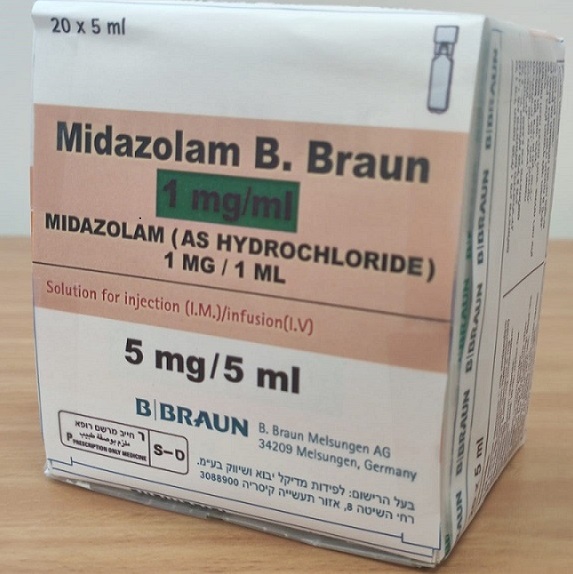Quest for the right Drug

מידאזולאם ב.בראון 1 מ"ג/מ"ל MIDAZOLAM B.BRAUN 1 MG/ML (MIDAZOLAM AS HYDROCHLORIDE)
תרופה במרשם
תרופה בסל
נרקוטיקה
ציטוטוקסיקה
צורת מתן:
תוך-שרירי, תוך-ורידי : I.M, I.V
צורת מינון:
תמיסה להזרקהאינפוזיה : SOLUTION FOR INJECTION / INFUSION
עלון לרופא
מינוניםPosology התוויות
Indications תופעות לוואי
Adverse reactions התוויות נגד
Contraindications אינטראקציות
Interactions מינון יתר
Overdose הריון/הנקה
Pregnancy & Lactation אוכלוסיות מיוחדות
Special populations תכונות פרמקולוגיות
Pharmacological properties מידע רוקחי
Pharmaceutical particulars אזהרת שימוש
Special Warning עלון לרופא
Physicians Leaflet
Adverse reactions : תופעות לוואי
4.8 Undesirable effects Table 4 summarises the undesirable effects which have been reported (frequency not known, cannot be estimated from the available data) to occur when midazolam is injected. Tabulated list of adverse reactions Frequency categories are as follows: Very common: ≥1/10 Common: ≥1/100 to <1/10 Uncommon: ≥1/1,000 to <1/100 Rare: ≥1/10,000 to <1/1,000 Very rare: <1/10,000 Not known (cannot be estimated from the available data) Table 4: Summary of adverse reactions Immune System Disorders frequency not known Hypersensitivity, angioedema, anaphylactic shock Psychiatric Disorders frequency not known Confusional state, disorientation, emotional and mood disturbances, changes in libido Physical drug dependence and withdrawal syndrome Abuse Paradoxical reactions* including; restlessness, agitation, irritability, nervousness, hostility, anger, aggressiveness, anxiety, nightmares, abnormal dreams, hallucinations, psychoses, inappropriate behaviour and other adverse behavioural effects, paroxysmal excitement Nervous System Disorders frequency not known Involuntary movements (including tonic/clonic movements and muscle tremor)*, hyperactivity* Sedation (prolonged and postoperative), alertness decreased, somnolence, headache, dizziness, ataxia, anterograde amnesia**, the duration of which is directly related to the administered dose Convulsions have been reported in premature infants and neonates Drug withdrawal convulsions Cardiac Disorders frequency not known Cardiac arrest, bradycardia, Kounis Syndrome**** Vascular Disorders frequency not known Hypotension, vasodilation, thrombophlebitis, thrombosis Respiratory Disorders frequency not known Respiratory depression, apnoea, respiratory arrest, dyspnea, laryngospasm, hiccups Gastrointestinal Disorders frequency not known Nausea, vomiting, constipation, dry mouth Skin and Subcutaneous Tissue Disorders frequency not known Rash, urticaria, pruritus General Disorders and Administration Site Conditions frequency not known Fatigue, injection site erythema, injection site pain Injury, Poisoning and Procedural Complications frequency not known Falls, fractures*** Social Circumstances frequency not known Assault* *Such paradoxical drug reactions have been reported, particularly among children and the elderly (see section 4.4). **Anterograde amnesia may still be present at the end of the procedure and in few cases prolonged amnesia has been reported (see section 4.4). ***There have been reports of falls and fractures in benzodiazepine users. The risk of falls and fractures is increased in those taking concomitant sedatives (including alcoholic beverages) and in the elderly. ****Particularly after parenteral administration. Renal impairment: There is a greater likelihood of adverse drug reactions in patients with severe renal impairment (see section 4.2). Dependence: Use of midazolam - even in therapeutic doses - may lead to the development of physical dependence. After prolonged i.v. administration, discontinuation, especially abrupt discontinuation of the product, may be accompanied by withdrawal symptoms including withdrawal convulsions (see section 4.4). Cases of abuse have been reported. Severe cardio-respiratory adverse events have occurred. Life-threatening incidents are more likely to occur in adults over 60 years of age and those with pre-existing respiratory insufficiency or impaired cardiac function, particularly when the injection is given too rapidly or when a high dosage is administered (see section 4.4). Reporting of suspected adverse reactions Reporting suspected adverse reactions after authorization of the medicinal product is important. It allows continued monitoring of the benefit/risk balance of the medicinal product. Any suspected adverse events should be reported to the Ministry of Health according to the National Regulation by using an online form (https://sideeffects.health.gov.il/).

שימוש לפי פנקס קופ''ח כללית 1994
לא צוין
תאריך הכללה מקורי בסל
לא צוין
הגבלות
לא צוין
מידע נוסף
